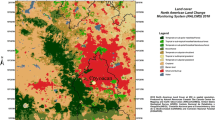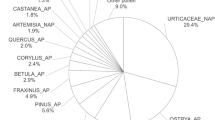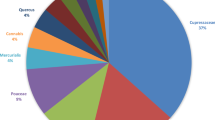Abstract
In the Tulsa area, the Cupressaceae is largely represented by eastern red cedar (Juniperus virginiana L.). The encroachment of this species into the grasslands of Oklahoma has been well documented, and it is believed this trend will continue. The pollen is known to be allergenic and is a major component of the Tulsa atmosphere in February and March. This study examined airborne Cupressaceae pollen data from 1987 to 2016 to determine long-term trends, pollen seasonal variability, and influence of meteorological variables on airborne pollen concentrations. Pollen was collected through means of a Burkard sampler and analyzed with microscopy. Daily pollen concentrations and yearly pollen metrics showed a high degree of variability. In addition, there were significant increases over time in the seasonal pollen index and in peak concentrations. These increases parallel the increasing population of J. virginiana in the region. Pollen data were split into pre- and post-peak categories for statistical analyses, which revealed significant differences in correlations of the two datasets when analyzed with meteorological conditions. While temperature and dew point, among others were significant in both datasets, other factors, like relative humidity, were significant only in one dataset. Analyses using wind direction showed that southerly and southwestern winds contributed to increased pollen concentrations. This study confirms that J. virginiana pollen has become an increasing risk for individuals sensitive to this pollen and emphasizes the need for long-term aerobiological monitoring in other areas.





Similar content being viewed by others
References
Aira MJ, Dopazo A, Jato MV (2001) Aerobiological monitoring of Cupressaceae pollen in Santiago de Compostela (NW Iberian Peninsula) over six years. Aerobiologia 17(3):319–325
Beggs PJ (2015) Environmental allergens: from asthma to hay fever and beyond. Curr Clim Chang Rep 1(3):176–184
Bitner RL (2011) Designing with conifers: the best choices for year-round interest in your garden. Timber Press, Portland
Bortenschlager S (1990) Aspects of pollen morphology in the Cupressaceae. Grana 29:129–137
Briggs JM, Hoch GA, Johnson LC (2002) Assessing the rate, mechanisms, and consequences of the conversion of tallgrass prairie to Juniperus virginiana forest. Ecosystems 5:578–586
Bunderson LD, Van de Water P, Wells H, Levetin E (2012) Predicting and quantifying pollen production in Juniperus ashei forests. Phytologia 94(3):417–438
Calderón-Ezquerro MC, Guerrero-Guerra C, Martínez-López B, Fuentes-Rojas F, Téllez-Unzueta F, López-Espinoza ED, Calderón-Segura ME, Martínez-Arroyo A, Trigo-Pérez MM (2016) First airborne pollen calendar for Mexico City and its relationship with bioclimatic factors. Aerobiologia 32:225–244
Caterina GL (2012) Juniperus virginiana encroachment into mesic grasslands: rainfall interception and tree water use. MS Thesis. Oklahoma State University, p 96
Charpin D, Calleja M, Lahoz C, Pichot C, Waisel Y (2005) Allergy to cypress pollen. Allergy 60:293–230
Dahl Å, Galán C, Hajkova L, Pauling A, Sikoparija B, Smith M, Vokou D (2013) The onset, course and intensity of the pollen season. In: Sofiev M, Bergman K-C (eds) Allergenic pollen. Springer, Netherlands
Díaz de la Guardia C, Alba-Sánchez F, Linares Fernández CD, Nieto-Lugilde D, López Caballero J (2006) Aerobiological and allergenic analysis of Cupressaceae pollen in Granada (Southern Spain). J Investig Allergol Clin Immunol 16(1):24–33
Drake B, Todd P (2002) A strategy for control and utilization of invasive juniper species in Oklahoma. Oklahoma Dept. of Agriculture, Food and Forestry, Oklahoma City, Oklahoma
Emberlin J, Savage M, Woodman R (1993) Annual variations in the concentrations of Betula pollen in the London area, 1961–1990. Grana 32(6):359–363
Engle DM, Bidwell TG, Moseley ME (1996) Invasion of Oklahoma rangelands and forests by eastern red cedar and Ashe juniper. Oklahoma Cooperative Extension Service, Division of Agricultural Sciences and Natural Resources, Oklahoma State University
Frei T, Gassner E (2006) Climate change and its impact on birch pollen quantities and the start of the pollen season an example from Switzerland for the period 1969–2006. Int J Biometeorol 52:667–674
Galán C, Fuillerat MJ, Comtois P, Dominguez-Vilches E (1998) Bioclimatic factors affecting daily Cupressaceae flowering in southwest Spain. Int J Biometeorol 41(3):95–100
Ganguli AC, Engle DM, Mayer PM, Salo LF (2016) Influence of resource availability on Juniperus virginiana expansion in a forest-prairie ecotone. Ecosphere 7(8):1–15
Garcia-Mozo H, Galan C, Aira MJ, Belmonte J, Díaz de la Guardia C, Fernandez D, Gutierrez AM, Rodríguez FJ, Trigo MM, Dominguez-Vilches E (2002) Modelling start of oak pollen season in different climatic zones in Spain. Agric For Meteorol 110:247–257
Gilman EF, Watson DG (2003) Juniperus virginiana: eastern red cedar. University of Florida IFAS Extension ENH-486, pp 1–5
Gioulekas D, Balafoutis C, Damialis A, Papakosta D, Gioulekas G, Patakas D (2004) Fifteen years’ record of airborne allergenic pollen and meteorological parameters in Thessaloniki, Greece. Int J Biometeorol 48(3):128–136
Gregory PH (1973) The microbiology of the atmosphere, 2nd edn. Halstead Press, New York
Hirst JM (1952) An automatic volumetric spore trap. Ann Appl Biol 39:257–265
Howard LE, Levetin E (2014) Ambrosia pollen in Tulsa, Oklahoma: aerobiology, trends, and forecasting model development. Ann Allergy Asthma Immunol 113:641–646
Korkut S, Hiziroglu S (2013) Selected properties of heat-treated eastern red cedar (Juniperus virginiana L.) wood. Bioresources 8(3):4756–4765
Levetin E (1998) A long-term study of winter and early spring pollen in Tulsa, Oklahoma. Aerobiologia 14:21–28
Levetin E, Buck P (1980) Hay fever plants of Oklahoma. Ann Allergy 45:26–32
Levetin E, Buck P (1986) Evidence of mountain cedar pollen in Tulsa. Ann Allergy 56:295–299
Levetin E, Van de Water P (2001) Environmental contributions to allergic disease. Curr Allergy Rep 1(6):506–514
Levetin E, Van de Water P (2003) Pollen count forecasting. Immunol Allergy Clin N Am 23(3):423–442
Levetin E, Rogers CA, Hall SA (2000) Comparison of pollen sampling with a Burkard spore trap and a Tauber trap in a warm temperate climate. Grana 39(6):294–302
Levetin E, Bunderson L, Van de Water P, Luvall J (2012) Is red-berry juniper an overlooked fall allergen in the Southwest? J Allergy Clin Immunol 129(2):AB91
Meneguzzo DM, Liknes GC (2015) Status and trends of eastern red cedar (J. virginiana) in the central United States: analyses and observations based on forest inventory and analysis data. J Forestry 113(3):325–334
Mohanty R, Buchheim M, Levetin E (2017) Molecular approaches for the analysis of airborne pollen: a case study of Juniperus pollen. Ann Allergy Asthma Immunol 118:204–211
Nilsson S, Persson S (1981) Tree pollen spectra in the Stockholm region (Sweden) 1973-1980. Grana 24:179–182
NOAA (2016) 2015 local climatological data, annual summary with comparative data. Tulsa, Asheville
Norris MD, Blair JM, Johnson LC, McKane RB (2001) Assessing changes in biomass, productivity, and C and N stores following Juniperus virginiana forest expansion into tallgrass prairie. Can J For Res 31:1940–1946
Pauling A, Gehrig R, Clot B (2014) Toward optimized temperature sum parameterizations for forecasting the start of the pollen season. Aerobiologia 30(1):45–57
Pettyjohn M, Levetin E (1997) Comparative biochemical study of conifer pollen allergens. Aerobiologia 13:259–267
Rodríguez de la Cruz D, Sánchez-Reyes E, Sánchez-Sánchez J (2015) A contribution to the knowledge of Cupressaceae airborne pollen in the middle west of Spain. Aerobiologia 31(4):435–444
Rogers C, Levetin E (1998) Evidence of long-distance transport of mountain cedar pollen into Tulsa, Oklahoma. Int J Biometeorol 42:65–72
Rogers C, Muilenberg M (2000) Pan-American Aerobiology Association Standardized Protocols. The Pan American Aerobiology Association
Sabariego S, Cuesta P, Fernández-González F, Pérez-Badia R (2012) Models for forecasting airborne Cupressaceae pollen levels in central Spain. Int J Biometeorol 56(2):253–258
Sánchez-Mesa JA, Smith M, Emberlin J, Allitt U, Caulton E (2003) Characteristics of grass pollen seasons in areas of southern Spain and the United Kingdom. Aerobiologia 19:243–250
Schwietz LA, Goetz DW, Whisman BA, Reid MJ (2000) Cross-reactivity among conifer pollens. Ann Allergy Asthma Immunol 84:87–93
Silva-Palacios I, Fernández-Rodríguez S, Durán-Barroso P, Tormo-Molina R, Maya-Manzano JM, Gonzalo-Garijo Á (2016) Temporal modelling and forecasting of the airborne pollen of Cupressaceae on the southwestern Iberian Peninsula. Int J Biometeorol 60(2):297–306
Smith S (2011) Eastern red-cedar: positives, negatives, and management. The Samuel Roberts Noble Foundation 1–8
Sofiev M, Siljamo P, Ranta H, Linkosalo T, Jaeger S, Rasmussen A, Rantio-Lehtimaki A, Severova E, Kukkonen J (2013) A numerical model of birch pollen emission and dispersion in the atmosphere. Description of the emission module. Int J Biometeorol 57(1):45–58
Twidwell D, Rogers WE, Fuhlendorf SD, Wonkka CL, Engle DM, Weir JR, Kreuter UP, Taylor CA (2013) The rising Great Plains fire campaign: citizens’ response to woody plant encroachment. Front Ecol Environ 11(Online Issue 1):e64–e71
Van de Water P, Levetin E (2001) The contribution of upwind pollen sources to the characterization of Juniperus ashei phenology. Grana 40:133–141
Van de Water P, Main CE, Keever T, Levetin E (2003) An assessment of predictive forecasting Juniperus ashei pollen movement in the southern Great Plains. Int J Biometeorol 48:74–82
Acknowledgements
The authors acknowledge the help of several laboratory assistants, research associates, graduate students, and numerous undergraduates with pollen counting over the 30 years. The authors also acknowledge the assistance of Dr. Harrington Wells with statistical analysis. Funding to the first author was provided by the Tulsa Undergraduate Research Challenge and the Oklahoma Louis Stokes Alliance for Minority Participation-NSF.
Author information
Authors and Affiliations
Corresponding author
Rights and permissions
About this article
Cite this article
Flonard, M., Lo, E. & Levetin, E. Increasing Juniperus virginiana L. pollen in the Tulsa atmosphere: long-term trends, variability, and influence of meteorological conditions. Int J Biometeorol 62, 229–241 (2018). https://doi.org/10.1007/s00484-017-1444-8
Received:
Revised:
Accepted:
Published:
Issue Date:
DOI: https://doi.org/10.1007/s00484-017-1444-8




